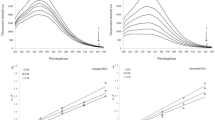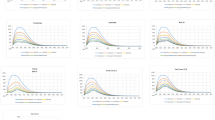Abstract
Allura red (AR) is a widely used colorant in food industry, but may have a potential security risk. In this study, the properties of interaction between AR and human serum albumin (HSA) in vitro were determined by fluorescence, UV–Vis absorption and circular dichroism (CD) spectroscopy combining with multivariate curve resolution–alternating least squares (MCR–ALS) chemometrics and molecular modeling approaches. An expanded UV–Vis data matrix was resolved by MCR–ALS method, and the concentration profiles and pure spectra for the three reaction components (AR, HSA, and AR–HSA complex) of the system were then successfully obtained to evaluate the progress interaction of AR with HSA. The calculated thermodynamic parameters indicated that hydrogen binding and hydrophobic interactions played major roles in the binding process, and the interaction induced a decrease in the protein surface hydrophobicity. The competitive experiments revealed that AR mainly located in Sudlow’s site I of HSA, and this result was further supported by molecular modeling studies. Analysis of CD spectra found that the addition of AR induced the conformational changes of HSA. This study have provided new insight into the mechanism of interaction between AR and HSA.






Similar content being viewed by others
References
Kashanian S, Zeidali SH, Omidfar K, Shahabadi N (2012) Multi-spectroscopic DNA interaction studies of sunset yellow food additive. Mol Biol Rep 39:10045–10051
Pourreza N, Rastegarzadeh S, Larki A (2011) Determination of allura red in food samples after cloud point extraction using mixed micelles. Food Chem 126:1465–1469
Tsuda S, Murakami M, Matsusaka N, Kano K, Taniguchi K, Sasaki YF (2001) DNA damage induced by red food dyes orally administered to pregnant and male mice. Toxicol Sci 61:92–99
Chung KT (2000) Mutagenicity and carcinogenicity of aromatic amines metabolically produced from Azo Dyes. J Environ Sci Heal C 18:51–74
Shimada C, Kano K, Sasaki YF, Sato I, Tsuda S (2010) Differential colon DNA damage induced by azo food additives between rats and mice. J Toxicol Sci 35:547–554
Feroz SR, Mohamad SB, Bujang N, Malek SNA, Tayyab S (2012) Multispectroscopic and molecular modeling approach to Investigate the interaction of flavokawain B with human serum albumin. J Agric Food Chem 60:5899–5908
Naveenraj K, Raj MR, Anandan S (2012) Binding interaction between serum albumins and perylene-3,4,9,10-tetracarboxylate—A spectroscopic investigation. Dyes Pigm 94:330–337
Zhang GW, Zhao N, Wang L (2011) Fluorescence spectrometric studies on the binding of puerarin to human serum albumin using warfarin, ibuprofen and digitoxin as site markers with the aid of chemometrics. J Lumin 131:2716–2724
Bolel P, Mahapatra N, Halder M (2012) Optical spectroscopic exploration of binding of cochineal red A with two homologous serum albumins. J Agric Food Chem 60:3727–3734
Zhou X, Li X, Chen XG (2013) Binding mechanism of Orange G to human serum albumin: saturation transfer difference-NMR, spectroscopic and computational techniques. Dyes Pigm 98:212–220
Zhao X, Sheng F, Zheng J, Liu R (2011) Composition and stability of anthocyanins from purple solanum tuberosum and their protective influence on Cr(VI) targeted to bovine serum albumin. J Agric Food Chem 59:7902–7909
Zhao X, Liu R, Chi Z, Teng Y, Qin P (2010) New insights into the behavior of bovine serum albumin adsorbed onto carbon nanotubes: comprehensive spectroscopic studies. J Phys Chem B 114:5625–5631
Tabassum S, Asbahy Wa M, Afzal M, Arjmand F (2012) Synthesis, characterization and interaction studies of copper based drug with human serum albumin (HSA): spectroscopic and molecular docking investigations. J Photochem Photobiol B 114:132–139
Maeder M (1987) Evolving factor analysis for the resolution of overpalling chromatographic peaks. Anal Chem 59:527–530
Zhang QL, Ni YN, Kokot S (2010) Molecular spectroscopic studies on the interaction between ractopamine and bovine serum albumin. J Pharm Biomed Anal 52:280–288
Vives M, Gargallo R, Tauler R (2000) Multivariate extension of the continuous variation and mole-ratio methods for the study of the interaction of intercalators with polynucleotides. Anal Chim Acta 424:105–114
Lakowicz JR (2006) Principles of fluorescence spectroscopy, 3rd edn. Springer, New York
Kitamura M, Murakami K, Yamada K, Kawai K, Kunishima M (2013) Binding of sulforhodamine B to human serum albumin: a spectroscopic study. Dyes Pigm 99:588–593
Mandal P, Ganguly T (2009) Fluorescence spectroscopic characterization of the interaction of human adult hemoglobin and two isatins, 1-methylisatin and 1-phenylisatin: a comparative study. J Phys Chem B 113:14904–14913
Xu T, Guo X, Zhang L, Pan F, Lv J, Zhang Y, Jin H (2012) Multiple spectroscopic studies on the interaction between olaquindox, a feed additive, and bovine serum albumin. Food Chem Toxicol 50:2540–2546
Hegde AH, Punith R, Seetharamappa J (2012) Optical, structural and thermodynamic studies of the association of an anti-leucamic drug imatinib mesylate with transport protein. J Fluoresc 22:521–528
Ross PD, Subramanian S (1981) Thermodynamics of protein association reactions: forces contributing to stability. Biochemistry 20:3096–3102
Zhang XP, Hou YH, Wang L, Zhang YZ, Liu Y (2013) Exploring the mechanism of interaction between sulindac and human serum albumin: Spectroscopic and molecular modeling methods. J Lumin 138:8–14
Cui FL, Hui GQ, Huo RN, Qu GR (2012) The binding characteristics of the interaction between 3-(2-cyanoethyl) cytosine and human serum albumin. Mol Biol Rep 39:9885–9891
Bijari N, Shokoohinia Y, Ashrafi-Kooshk MR, Ranjbar S, Parvaneh S, Moieni-Arya M, Khodarahmi R (2013) Spectroscopic study of interaction between osthole and human serum albumin: identification of possible binding site of the compound. J Lumin 143:328–336
Mehrabi M, Ghobadi S, Khodarahmi R (2009) Spectroscopic study on the interaction of celecoxib with human carbonic anhydrase II: thermodynamic characterization of the binding process. J Photochem Photobiol B 97:61–168
Khodarahmi R, Karimi SA, Kooshk MRA, Ghadami SA, Ghobadi S, Amani M (2012) Comparative spectroscopic studies on drug binding characteristics and protein surface hydrophobicity of native and modified forms of bovine serum albumin: possible relevance to change in protein structure/function upon non-enzymatic glycation. Spectrochim Acta A 89:177–186
Föster T, Sinanoglu O (eds) (1996) Modern quantum chemistry. Academic Press, New York
Naik PN, Chimatadar SA, Nandibewoor ST (2010) Interaction between a potent corticosteroid drug–dexamethasone with bovine serum albumin and human serum albumin: a fluorescence quenching and fourier transformation infrared spectroscopy study. J Photochem Photobiol B 100:147–159
Curry S (2009) Lessons from the crystallographic analysis of small molecule binding to human serum albumin. Drug Metab Pharmacok 24:342–357
Ding F, Diao JX, Sun Y, Sun Y (2012) Bioevaluation of human serum albumin-hesperidin bioconjugate: insight into protein vector function and conformation. J Agric Food Chem 60:7218–7228
Brodersen R, Sjödin T, Sjöholm I (1977) Independent binding of ligands to human serum albumin. J Biol Chem 252:5067–5072
Tang J, Luan F, Chen X (2006) Binding analysis of glycyrrhetinic acid to human serum albumin: fluorescence spectroscopy, FTIR, and molecular modeling. Bioorg Med Chem 14:3210–3217
Xie XY, Wang ZW, Zhou XM, Wang X, Chen XG (2011) Study on the interaction of phthalate esters to human serum albumin by steady-state and time-resolved fluorescence and circular dichroism spectroscopy. J Hazard Mater 192:1291–1298
Lu Z, Zhang YY, Liu H, Yuan JL, Zheng ZL, Zou GL (2007) Transport of a cancer chemopreventive polyphenol, resveratrol: interaction with serum albumin and hemoglobin. J Fluoresc 17:580–587
Shahabadi N, Maghsudi M, Rouhani S (2012) Study on the interaction of food colourant quinoline yellow with bovine serum albumin by spectroscopic techniques. Food Chem 135:1836–1841
Jana S, Dalapati S, Ghosh S, Guchhait N (2012) Potential charge transfer probe induced conformational changes of model plasma protein human serum albumin: spectroscopic, molecular docking, and molecular dynamics simulation study. Biopolymers 97:766–777
Acknowledgments
We gratefully acknowledge the financial support of the National Natural Science Foundation of China (Nos. 31060210 and 21167013), the Research Program of State Key Laboratory of Food Science and Technology, Nanchang University (Nos. SKLF–ZZB–201305, SKLF–ZZA–201302, and SKLF–KF–201203), the Natural Science Foundation of Jiangxi Province (20114BAB204019), the Program of Jiangxi Provincial Department of Science and Technology (20112BBF60010), and the Jiangxi Provincial Postgraduate Innovation Fund (YC2013-S049).
Author information
Authors and Affiliations
Corresponding author
Rights and permissions
About this article
Cite this article
Wang, L., Zhang, G. & Wang, Y. Binding properties of food colorant allura red with human serum albumin in vitro. Mol Biol Rep 41, 3381–3391 (2014). https://doi.org/10.1007/s11033-014-3200-z
Received:
Accepted:
Published:
Issue Date:
DOI: https://doi.org/10.1007/s11033-014-3200-z




